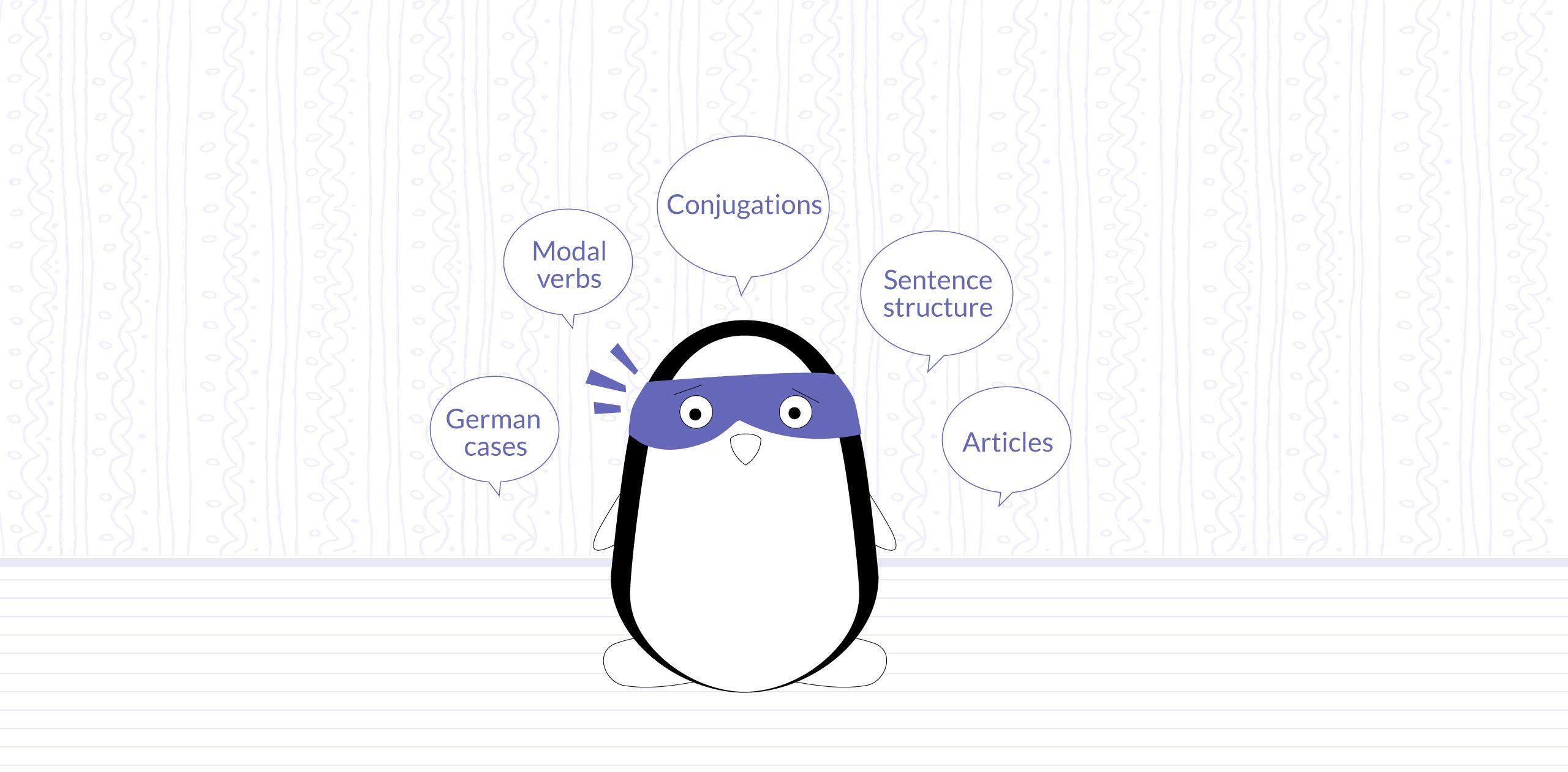
German has several types of pronouns, each of them used in different grammatical constructions. German pronouns are an important part of learning the language and can be difficult to learn for beginners – however, they can also be your key to mastering other parts of German grammar.
In this article, let's explore the types of German pronouns and discover how to use them correctly. If you want to speak German fluently, read on and boost your knowledge.
Learn German with Langster
Personal Pronouns
Pronouns are short, simple words that replace people and objects in sentences, such as "I," "he," "they," etc. A pronoun can substitute a noun or a noun phrase.
German personal pronouns are the first and most basic thing you come across when starting out with this language. After all, when starting to speak, you first need to know how to say “I” in German.
Just like in English, in the German language, personal pronouns are used all the time. However, while they might look straightforward at first sight, the situation is not as simple.
In English, we have seven personal pronouns we use for the subject of the sentence: I, you, he, she, it, we, and they. We then have seven pronouns used when the person or thing is not the subject of the sentence: me, you, him, her, it, us, and them. In German, the situation gets a little bit more complicated.
Additional Pronouns
In English, every pronoun corresponds to one grammatical entity in singular and in plural. In German, however, there are several additional pronouns:
- Four different types of "you." In German, there's the informal version of "you" (du), the formal one, or the royal "You" (Sie), and, of course, their plural versions.
- Three different types of "it." While in English, we don't differentiate between the grammatical genders of "it" in the sentence, Germans do. So, there's masculine "it" (er), the feminine one (sie), and the neuter one, of course (es). This is another reason why it's so important to learn German nouns together with their gender.
And yes, as you might have noticed, the German pronoun sie can be used in three different contexts: for formal "you," plural "you," and "she."
German Subject Pronouns and Non-Subject Pronouns
There are several subject pronouns (or nominative pronouns) in German that correspond to the English subject pronouns we mentioned above. However, there are also two other groups of personal pronouns called non-subject pronouns that you should use in the accusative case (direct object pronouns) and dative case (indirect object pronouns).
Yes, German cases are everywhere.
And yes, this means that you will have to learn not only every nominative personal pronoun (which is quite easy) but also every accusative personal pronoun and dative personal pronoun (which can be quite a headache).
German Personal Pronouns: The Table
Now, here they are:
| English | Nominative | Accusative | Dative |
|---|---|---|---|
| I | ich | mich | mir |
| You (personal) | du | dich | dir |
| You (formal) | Sie | Sie | Ichnen |
| He | er | ihn | ihm |
| She | sie | sie | ihr |
| It | es | es | ihm |
| We | wir | uns | uns |
| You (personal plural) | ihr | euch | euch |
| You (formal plural) | Sie | Sie | Ichnen |
| They | sie | sie | ihnen |
| English | Nominative | Accusative | Dative |
|---|---|---|---|
| I | ich | mich | mir |
| You (personal) | du | dich | dir |
| You (formal) | Sie | Sie | Ichnen |
| He | er | ihn | ihm |
| She | sie | sie | ihr |
| It | es | es | ihm |
| We | wir | uns | uns |
| You (personal plural) | ihr | euch | euch |
| You (formal plural) | Sie | Sie | Ichnen |
| They | sie | sie | ihnen |
How to Learn Personal Pronouns Faster?
Of course, you don't have to try to memorize each pronoun. Instead, we suggest you look for patterns and group the pronouns by them. For example:
- some pronouns, like uns and euch, repeat in the accusative and dative case.
- some pronouns, like mich and dich, rhyme.
- the third-person singular pronouns correspond to the declination endings.
- and, of course, royal "You" is the same in the singular and plural.
How to Use German Personal Pronouns?
Fortunately, this part is simple.
Like many other parts of speech, German personal pronouns follow specific grammatical rules. The basic rule says that you should use a pronoun for a corresponding noun according to its position in the sentence (and, thus, case): subject, indirect object, or direct object. Of course, if the subject or object is plural, you should use plural pronouns.
And, don't forget about gender. It can be challenging to determine the gender of certain nouns, so take your time with that. Use a dictionary when you can't figure out the gender and rely more on your memorization skills rather than logic. When it comes to German grammatical gender, logic can be a false friend.
And, finally, a few examples:
German
English
Ich habe ihn gestern gesehen.
I saw him yesterday.
Gib es mir.
Give it to me.
Wovon reden Sie?
What are you talking about?

Possessive Pronouns
Another type of pronoun that you should learn is the possessive group. Possessive pronouns, of course, are used to express possession or ownership and correspond roughly to the English "my," "your," "his/her/its," and so on.
However, there is one notable difference between German and English possessive pronouns: German pronouns have to agree in gender, number, and case with the noun they correspond with. So, there will be a huge difference between “my pencil” and “my pencils,” and that’s just the nominative case.
Are you ready to see a huge chart? Right, nobody is, so we’ve divided it into four parts.
Masculine:
| personal | possessive nominative | possessive accusative | possessive dative |
|---|---|---|---|
| ich | meiner | meinen | meinem |
| du | deiner | deinen | deinem |
| er | seiner | seinen | seinem |
| sie | ihrer | ihren | ihrem |
| es | seiner | seinen | seinem |
| wir | unserer | unseren | unserem |
| ihr | eurer | euren | eurem |
| sie | ihrer | ihren | ihrem |
| Sie | ihrer | Ihren | Ihrem |
| personal | possessive nominative | possessive accusative | possessive dative |
|---|---|---|---|
| ich | meiner | meinen | meinem |
| du | deiner | deinen | deinem |
| er | seiner | seinen | seinem |
| sie | ihrer | ihren | ihrem |
| es | seiner | seinen | seinem |
| wir | unserer | unseren | unserem |
| ihr | eurer | euren | eurem |
| sie | ihrer | ihren | ihrem |
| Sie | ihrer | Ihren | Ihrem |
Feminine:
| personal | possessive nominative | possessive accusative | possessive dative |
|---|---|---|---|
| ich | meine | meine | meiner |
| du | deine | deine | deiner |
| er | seine | seine | seiner |
| sie | ihre | ihre | ihrer |
| es | seine | seine | seiner |
| wir | unsere | unsere | unserer |
| ihr | eure | eure | eurer |
| sie | ihre | ihre | ihrer |
| Sie | Ihre | Ihre | Ihrer |
| personal | possessive nominative | possessive accusative | possessive dative |
|---|---|---|---|
| ich | meine | meine | meiner |
| du | deine | deine | deiner |
| er | seine | seine | seiner |
| sie | ihre | ihre | ihrer |
| es | seine | seine | seiner |
| wir | unsere | unsere | unserer |
| ihr | eure | eure | eurer |
| sie | ihre | ihre | ihrer |
| Sie | Ihre | Ihre | Ihrer |
Neuter:
| personal | possessive nominative | possessive accusative | possessive dative |
|---|---|---|---|
| ich | meins | meins | meinem |
| du | deins | deins | deinem |
| er | seins | seins | seinem |
| sie | ihr(e)s | ihr(e)s | ihrem |
| es | seins | seines | seinem |
| wir | unseres | unseres | unserem |
| ihr | eures | eures | eurem |
| sie | ihr(e)s | ihr(e)s | ihrem |
| Sie | Ihr(es) | Ihr(es) | Ihrem |
| personal | possessive nominative | possessive accusative | possessive dative |
|---|---|---|---|
| ich | meins | meins | meinem |
| du | deins | deins | deinem |
| er | seins | seins | seinem |
| sie | ihr(e)s | ihr(e)s | ihrem |
| es | seins | seines | seinem |
| wir | unseres | unseres | unserem |
| ihr | eures | eures | eurem |
| sie | ihr(e)s | ihr(e)s | ihrem |
| Sie | Ihr(es) | Ihr(es) | Ihrem |
Note: the letters written in brackets are optional, so sometimes, there are two valid ways to say something.
Plural:
| personal | possessive nominative | possessive accusative | possessive dative |
|---|---|---|---|
| ich | meine | meine | meinen |
| du | deine | deine | deinen |
| er | seine | seine | seinen |
| sie | ihre | ihre | ihren |
| es | seine | seine | seinen |
| wir | unsere | unsere | unseren |
| ihr | eure | eure | euren |
| sie | ihre | ihre | ihren |
| Sie | Ihre | Ihre | Ihren |
| personal | possessive nominative | possessive accusative | possessive dative |
|---|---|---|---|
| ich | meine | meine | meinen |
| du | deine | deine | deinen |
| er | seine | seine | seinen |
| sie | ihre | ihre | ihren |
| es | seine | seine | seinen |
| wir | unsere | unsere | unseren |
| ihr | eure | eure | euren |
| sie | ihre | ihre | ihren |
| Sie | Ihre | Ihre | Ihren |
How to Learn Possessive Pronouns?
Don’t worry, it’s not as scary as it seems. All you have to do is start with the root of the correct nominative possessive pronoun, then simply add an appropriate ending depending on the number, gender, and case.
That’s simple, see:
German
English
Geh von meinem Auto weg.
Get away from my car.
Das ist nicht dein Auto.
This is not your car.
Ich habe dein Auto mit meinem verwechselt.
I've mistaken your car for mine.

Reflexive Pronouns
Reflexive pronouns are used when the subject and object are the same. You can use a reflexive pronoun when the action is directed back toward yourself or another person who is involved in the situation, like in this sentence: "I hurt myself."
In German, reflexive pronouns are mostly used with reflexive verbs (eg. to wash oneself). And, they can be either in the accusative case (when the action is directed at someone) or dative case (when someone is affected by the action).
What’s amazing about them is that you already know most of them, except one. Both accusative and dative reflexive pronouns mostly correspond to the personal pronouns in the same cases. The only word you need to learn is sich – you will use it for the third-person pronouns (you, he, she, it) and the second-person pronoun Sie.
German
English
Hast du dich heute Morgen nicht gewaschen?
Didn't you wash this morning?
Er hat sich einen neuen Fernseher gekauft.
He bought himself a new TV.
Demonstrative Pronouns
And now, to the simpler things. Demonstrative pronouns are extremely helpful and simply mean something like “this,” “that,” “these,” and “those.”
Here they are:
| Case | Masc. | Fem. | Neut. | Plural |
|---|---|---|---|---|
| Nom. | dieser | diese | dieses | diese |
| Acc. | diesen | diese | dieses | diese |
| Dat. | diesem | dieser | diesem | diesen |
| Gen. | dieses | dieser | dieses | dieser |
| Case | Masc. | Fem. | Neut. | Plural |
|---|---|---|---|---|
| Nom. | dieser | diese | dieses | diese |
| Acc. | diesen | diese | dieses | diese |
| Dat. | diesem | dieser | diesem | diesen |
| Gen. | dieses | dieser | dieses | dieser |
For example:
German
English
Ich kenne diese Frau nicht.
I don’t know this woman.
Relative Pronouns
The next group of German pronouns is relative pronouns, which are words that introduce relative clauses. They correspond to the English "that" or "which," but while in English, we often leave them out, in German, we need to say them.
There are just two relative pronouns in German: der (who or what) and welcher (which). Just like other pronouns, they change according to number and gender.
Here they are:
| Case | Mascul. | Fem. | Neut. | Plural |
|---|---|---|---|---|
| Nom. | der / welcher | die / welche | das / welche | die / welche |
| Acc. | den / welchen | die / welche | das / welches | die / welche |
| Dat. | dem / welchem | der / welcher | dem / welchem | denen / welchen |
| Gen. | dessen | deren | dessen | deren |
| Case | Mascul. | Fem. | Neut. | Plural |
|---|---|---|---|---|
| Nom. | der / welcher | die / welche | das / welche | die / welche |
| Acc. | den / welchen | die / welche | das / welches | die / welche |
| Dat. | dem / welchem | der / welcher | dem / welchem | denen / welchen |
| Gen. | dessen | deren | dessen | deren |
And an example:
German
English
Die Katze, die ich gestern gesehen habe, war weiß.
The cat (that) I saw yesterday was white.

Interrogative Pronouns
Interrogative pronouns are simply question words, which correspond to English "who," "what," "how,” etc. And, luckily, they are not declined (except one).
| Pronoun | Translation |
|---|---|
| wie | how |
| was | what |
| wo | where |
| wann | when |
| warum | why |
| wer | who (nominative) |
| wem | (to) whom (dative) |
| wen | whom (accusative) |
| wessen | whose (genitive) |
| Pronoun | Translation |
|---|---|
| wie | how |
| was | what |
| wo | where |
| wann | when |
| warum | why |
| wer | who (nominative) |
| wem | (to) whom (dative) |
| wen | whom (accusative) |
| wessen | whose (genitive) |
An example:
German
English
Wer hat an die Tür geklopft?
Who knocked on the door?
You can read more about German question words in our article here.
Indefinite Pronouns
Finally, we’ve come to the indefinite pronouns. These are words like “someone,” “something,” “all,” “many,” etc. Some of them, like etwas (“something”) and nichts (“nothing”) have only one form, while others change their endings according to cases.
The most common indefinite pronouns in German are:
German
English
irgendjemand, irgendwer
anyone
man
one
jeder
everyone
niemand
nobody
keiner, keine, kein
no one
alle
all
jeder, jede, jedes
everyone

Bottom Line
German pronouns can be a little confusing and complex, with multiple cases and forms. But, by learning the different types of German pronouns – personal, possessive, reflexive, demonstrative, relative, interrogative, and indefinite – you can understand German grammar on a much deeper level.
So, don’t wait. Start studying today!









